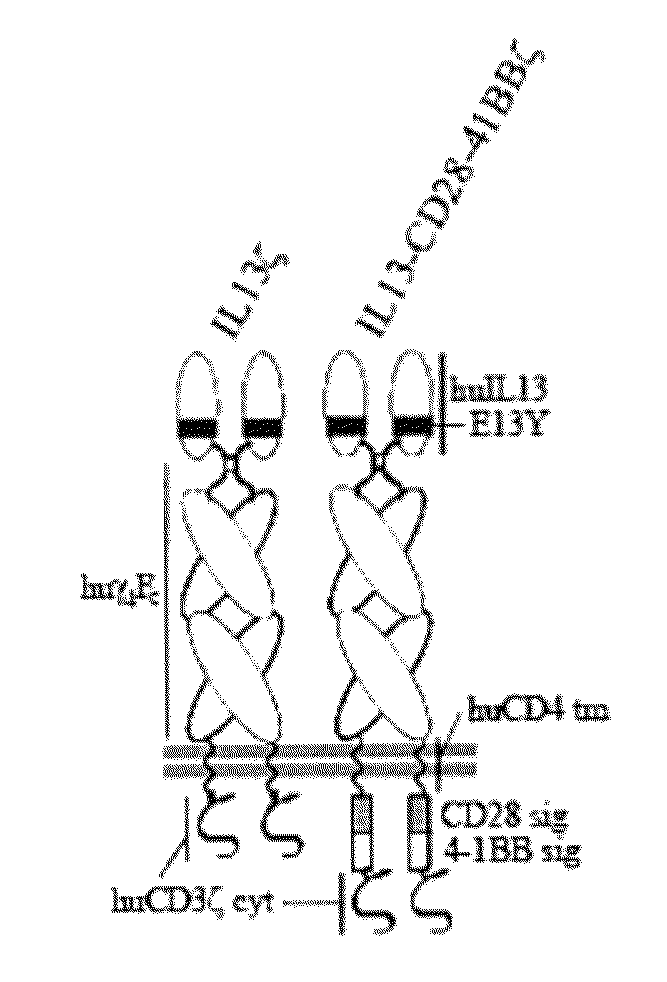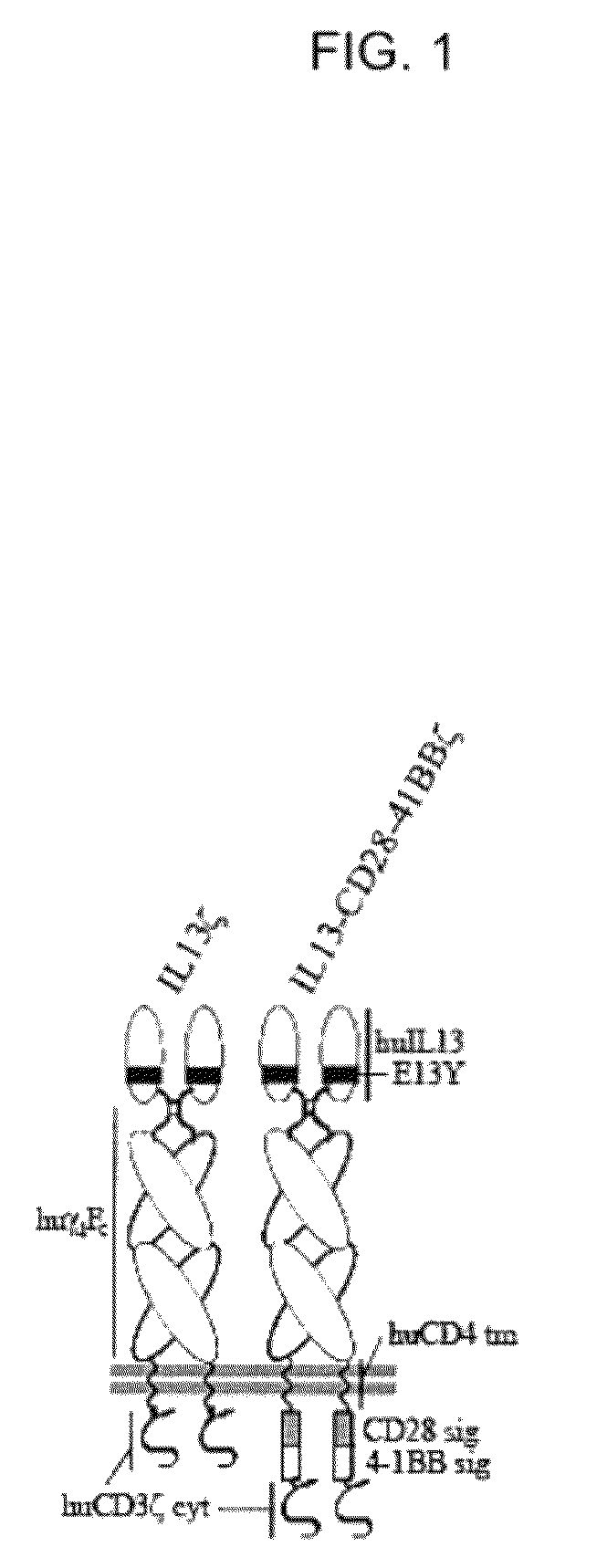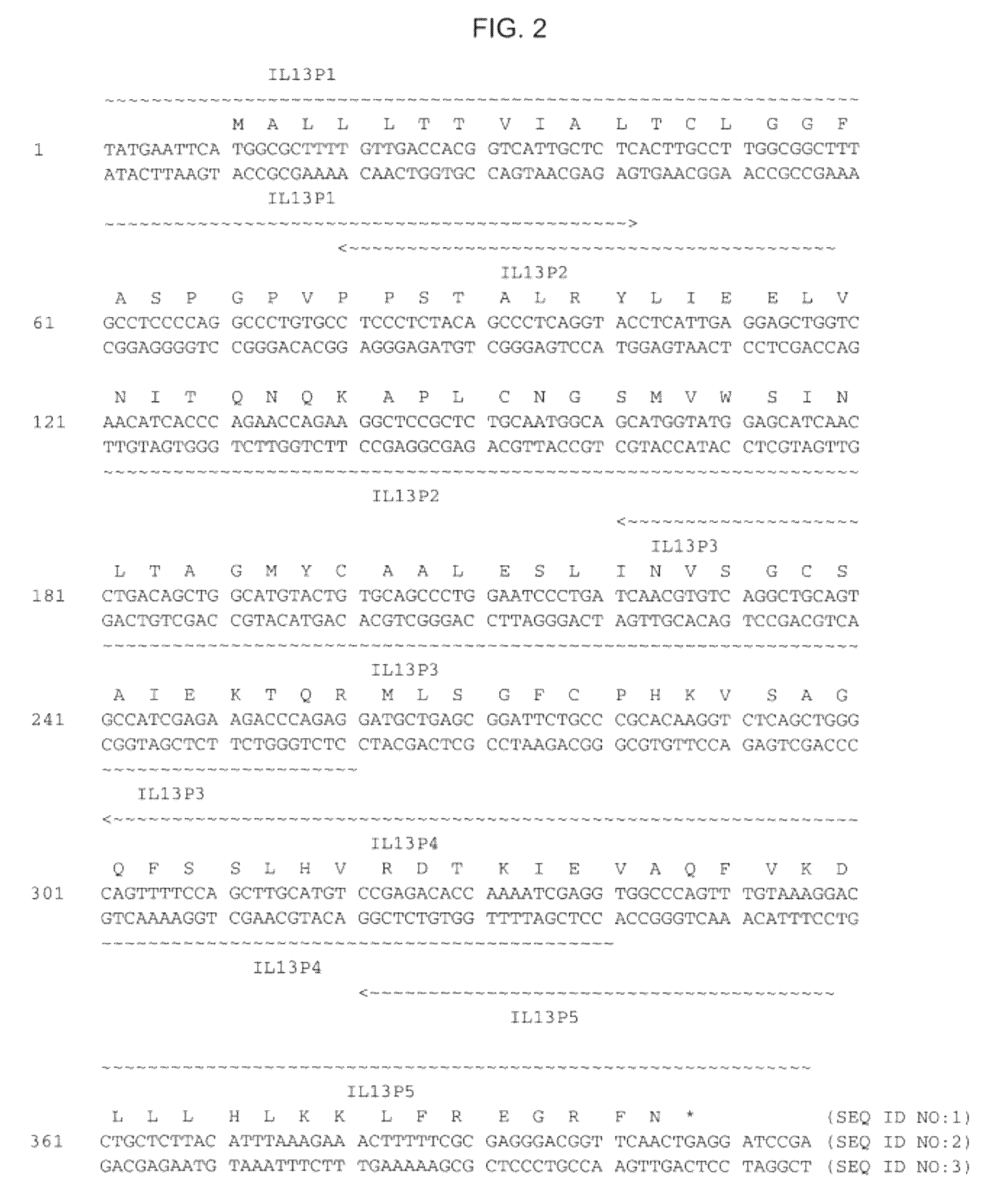Method and compositions using a chimeric antigen receptor for enhanced anti-tumor effector functioning of T cells
a technology of chimeric antigen receptor and t cell, applied in the field of biomedicine, can solve the problems of not having the desired potency and duration of tumor cell killing, t cells that adoptively transfer, and cannot survive and remain active in vivo, and achieve the effect of enhancing the anti-tumor effector function
- Summary
- Abstract
- Description
- Claims
- Application Information
AI Technical Summary
Benefits of technology
Problems solved by technology
Method used
Image
Examples
example 1
Transfection and Expression of IL13Rα2-Specific Chimeric Receptors in Primary Human T Lymphocytes
[0057]To engage both T cell receptor (TCR)- and costimulatory-like signaling cascades upon interaction with glioma tumor antigen IL13Rα2, signaling elements derived from CD28 and 4-1BB were integrated into an IL13-zetakine (IL13ζ) chimeric antigen receptor (CAR). The preferred IL13ζ CAR is composed of the extracellular IL13(E13Y) mutein, human IgG4 hinge-Fc linked to the human cytoplasmic CD3ζ via the transmembrane domain of human CD4. See FIG. 1. De novo synthesis of the IL13(E13Y) coding sequence was performed using primers IL13P1, IL13P2, IL13P3, IL13P4, and IL13P5. See Table I, below, and FIG. 2. The final sequence (417 bp) was end-digested with EcoRI-BamHI, and ligated into the plasmid pSK (Stratagene™) as ligation 312#3. Ligation 312#3 was mutagenized (Stratagene™ kit, per manufacturer's instructions) to repair a deleted nucleotide using the primers IL13 312#3 mut5-3 and IL13 312#3...
example 2
Potentiation of JNK and p38 MAPK Signaling with Sustained AKT Signaling by IL13-CD28-41BBζ
[0070]T cells stimulated by the engagement of the TCR-CD3 complex along with the auxiliary receptors CD28 or 4-1BB are known to drive signals through AKT as well as the mitogen-activated protein kinases (MAPKs). To investigate the ability of costimulatory CARs to influence these downstream effector pathways, in vitro kinase assays were used to evaluate and compare the activity of AKT and MAPK family members ERK, JNK and p38 in IL13ζ- and IL13-CD28-41BBζ-expressing CD4+ T cells following engagement of U87 target cells. Human glioma line, U87, was obtained from ATCC (Rockville, Md.). All tumor lines are adherent, and were grown in DMEM (Irvine Scientific™) supplemented with 10% heat-inactivated FCS, 25 mM HEPES, and 2 mM L-glutamine. CD4+ T cells expressing IL13ζ or IL13-CD28-41BBζ CAR were incubated with U87 glioma cells for the times indicated in FIG. 10 prior to assay.
[0071]After IL13ζ- or IL1...
example 3
Costimulation Signals Enforce Th1 Polarization of Tumor Re-Directed CD4+ Effectors
[0075]Because p38 activity has been detected in Th1 but not Th2 cells, and JNK / p38 activation is known to induce Th1 production of associated TNF-α and IFN-γ cytokines, the effect of CD28 and 4-1BB costimulatory function on CAR-mediated induction of Th1-associated cytokines was investigated. Genetically modified CD4+ T cells (106 cells) expressing IL13ζ or IL13-CD28-41BBζ were co-cultured in 24-well tissue culture plates with different stimulator cells (5×105 cells) in 2 mL of culture medium. The stimulator cells were U87 glioma cells (U87), parental NS0 mouse myeloma cells (NS0), NS0 cells stably expressing surface IL13Rα2 (NS0-IL13Rα2) or NS0 cells stably expressing membrane bound OKT3 (NS0-OKT3) as indicated in FIG. 11A.
[0076]Real-time quantitative RT-PCR (qPCR) was used to measure relative mRNA levels after culture. For gene expression analysis, total cellular RNA of the CD4+ T cell transfectants w...
PUM
| Property | Measurement | Unit |
|---|---|---|
| pH | aaaaa | aaaaa |
| concentration | aaaaa | aaaaa |
| volume | aaaaa | aaaaa |
Abstract
Description
Claims
Application Information
 Login to View More
Login to View More - R&D
- Intellectual Property
- Life Sciences
- Materials
- Tech Scout
- Unparalleled Data Quality
- Higher Quality Content
- 60% Fewer Hallucinations
Browse by: Latest US Patents, China's latest patents, Technical Efficacy Thesaurus, Application Domain, Technology Topic, Popular Technical Reports.
© 2025 PatSnap. All rights reserved.Legal|Privacy policy|Modern Slavery Act Transparency Statement|Sitemap|About US| Contact US: help@patsnap.com



